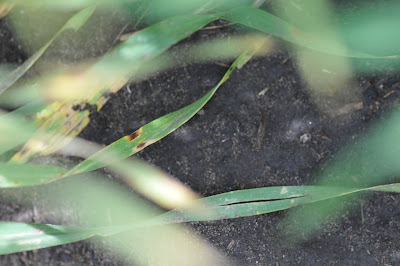Symptoms of bacterial leaf streak observed in barley, southern Alberta, May 23, 2023
With crops emerging, it’s time to scout for pests and diseases that can reduce yield. Don’t forget to add bacterial leaf streak (caused by Xanthomonas translucens) to your cereal diseases scouting list. Symptoms of this disease – such as water-soaking lesions along the midrib of early leaves – have already been reported in barley in southern Alberta in the county of Warner around May 23rd. Water soaked streaks are the initial symptoms followed by yellowing and necrosis of the affected areas. During wet conditions droplets of bacterial ooze may be observed on leaf lesions, while dried ooze tends to have a "glazed doughnut" appearance.
While there are no in-season management options for control of bacterial leaf streak, monitoring and recording the appearance, progress and impact of the disease will help you learn by experience what might be expected in subsequent years.
Management recommendations include:
- Use seed with little or no detectable bacterial leaf streak risk
- Rotate crops to provide at least a two-year break between cereal crops
- If possible, allow the canopy to dry thoroughly between irrigation events
Photos showing bacterial leaf streak symptoms from a barley field in southern Alberta, May 23, 2023, courtesy of Joshua Leffers, independent agronomist.
Photos of cereal seedling water soaking and more mature lesions with bacterial oozing due to bacterial leaf streak, courtesy of Drs. Connie Fleitas and Randy Kutcher, University of Saskatchewan, Saskatoon, SK.
Prairie Crop Disease Monitoring Network, Quick Disease Reporter Tool Update map for bacterial leaf streak as of May 25, 2023. Map courtesy of Matthew McBurney, GIS Data Modeller, AAFC Winnipeg.

Bacterial leaf streak symptoms on barley seedling leaves are quite distinct from those caused by the fungal leaf spot complex that includes scald, net- and spot-form net blotch, and spot blotch. Scald initially starts out as oval lesions that can have a water-soaked appearance. However, lesions then turn a grayish or turquoise colour, while mature scald lesions have a tan coloured interior with dark purple-brown borders and yellowing around the lesions. Net and spot blotch symptoms start off as small brownish lesions that may be oval in shape. As the infection progresses and the lesions mature, there can be yellowing around the brownish lesions. Net-form net blotch lesions can have a netted appearance with lesions being long and narrow, while symptoms of spot-form net blotch or spot blotch will be more oval to oblong in shape. Confirmation of scald and net-form net blotch is fairly straightforward as symptoms are quite diagnostic, while differentiating symptoms of spot-form net blotch from spot blotch will require laboratory analyses.
More information on typical cereal leaf disease symptoms can be found at the following Prairie Crop Disease Monitoring Network (PCDMN) links:
Net-form net blotch in barley
Spot-form net blotch in barley
Scald in barley
Spot blotch in barley
Bacterial leaf streak (for wheat, but symptoms and management are similar for barley)
Typical photos of leaf spots in barley
Net-form net blotch from seedling leaves, AAFC Lacombe 2022
Early net-form net blotch lesions, AAFC Lacombe, 2019
More developed net-form net blotch lesions, AAFC Lacombe 2019
Mature net-form net blotch lesions, AAFC Lacombe 2019
Mature spot-form net blotch lesions, AAFC Lacombe 2019
Early spot-form net blotch lesions, AAFC Lacombe 2016
Mature spot-form net blotch lesions, AAFC Lacombe 2019
Early and more advanced spot blotch lesions, AAFC Lacombe 2011
Mature spot blotch lesions, AAFC Lacombe 2011
Mature spot blotch lesions, AAFC Lacombe 2011
Mature spot blotch lesions, AAFC Brandon 2019
Early scald lesion, Adelaide/Barossa Valley area, South Australia, 2008
More advanced scald lesions, Adelaide/Barossa Valley area, South Australia, 2008
Mature scald lesions, Adelaide/Barossa Valley area, South Australia, 2008
Mature scald lesions, AAFC Lacombe 2019
The PCDMN wishes to
acknowledge Michael Harding, Alberta Agriculture and Irrigation and Joshua
Leffers, independent agronomist for sharing the initial report of bacterial leaf streak at
the seedling stage from southern Alberta, May 23, 2023. Photos showing various symptoms of bacterial leaf streak from Drs. Connie Fleitas and Randy Kutcher, University of Saskatchewan are also sincerely acknowledged.






































